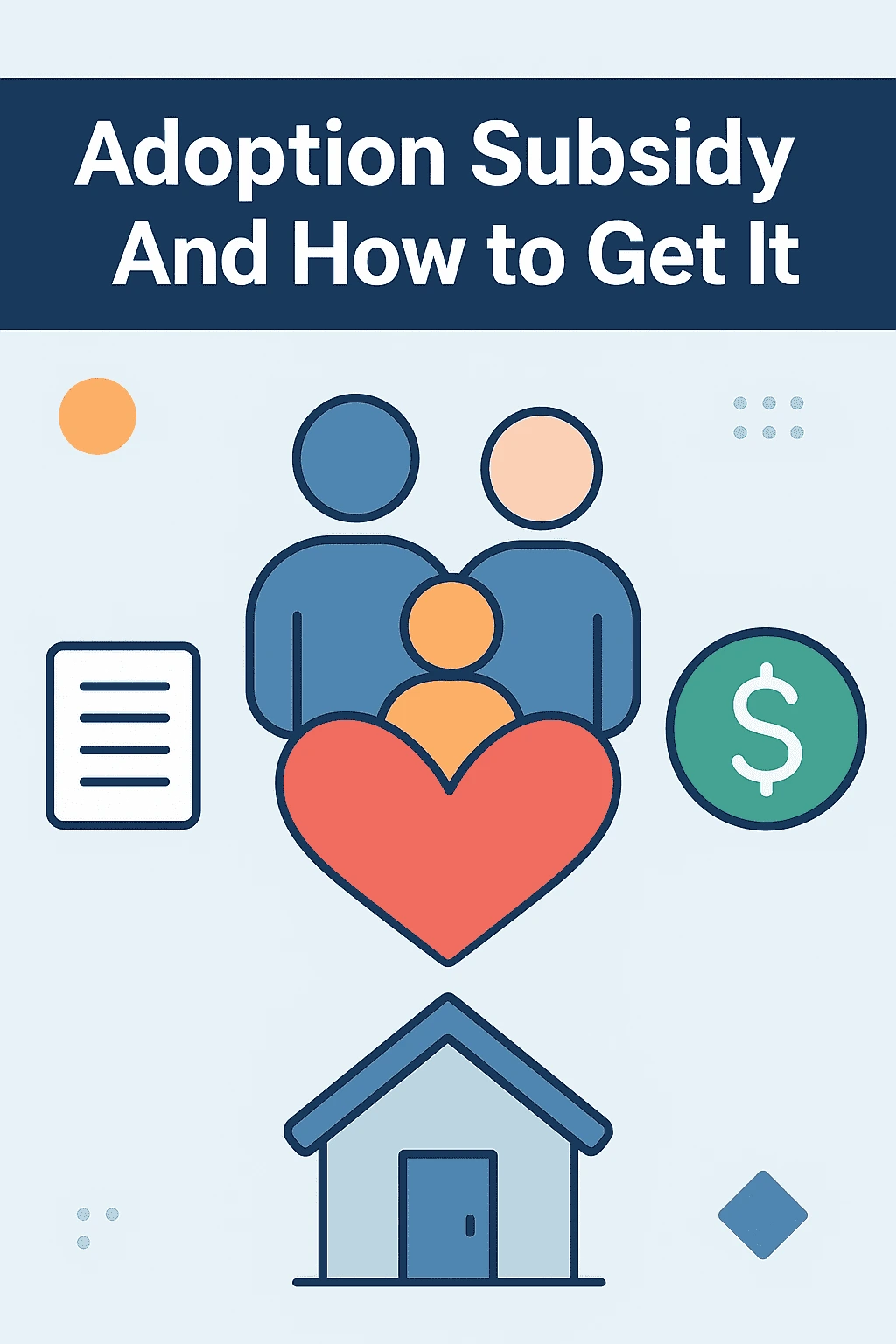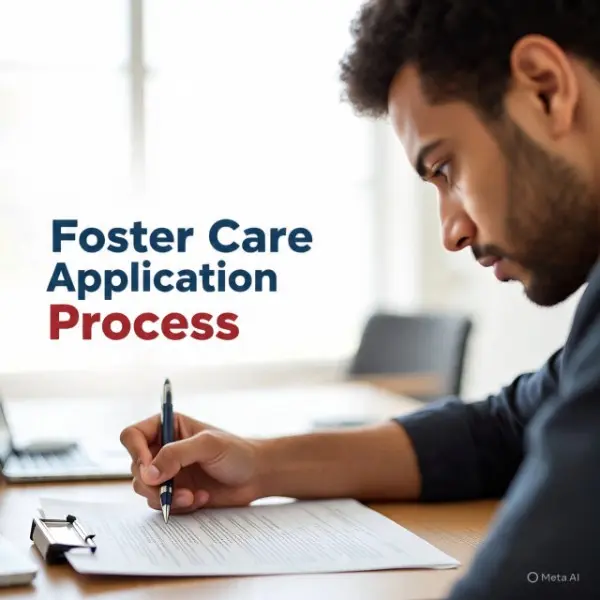Adoption Subsidy: 7 Facts You Need To Know Immediately

Are you looking for how to navigate the complex world of adoption subsidy programs? You are not alone. Whether you are just starting out your adoption journey or you’re already in the process, it is good to understand that subsidies can make a unique financial difference for your family.
These unique support systems have helped thousands, not millions, of families provide homes to children with special needs every year, yet many adopting parents are ignorant of how these benefits work or if they are eligible for the adoption subsidy.
This guide is to break down seven critical facts about adoption subsidy programs that will make your adoption journey simpler before you decide on the adoption path.
What Exactly Is an Adoption Subsidy?
An adoption Subsidy is a kind of financial assistance provided to families who adopt children with special needs from foster care. This is created under the Adoption Assistance and Child Welfare Act of 1980; the aim of these programs is to remove financial challenges that might prevent prospective adoptive parents from adopting children who need loving homes.
Related posts:
10 Things You Must Know About Adoption Tax Credits.
7 Benefits Support Services You Need to Know.
Sure Ways To Get Adoption Grants Now.
The Powerful And Tested Adoption Resources For Adoptive Parents.
The subsidy payment came into being because lawmakers found out that families who are willing to adopt children with challenging backgrounds or conditions should not face these hardships for their goodwill.
Federal vs. State Adoption Assistance Programs:
Adoption subsidies can be classified into two categories: Federal Title IV-E adoption assistance and state-funded adoption assistance. Title IV-E subsidies are in line with federal guidelines and receive partial federal funding.
The state programs differ greatly depending on which state you are adopting from, and whether they are eligible under federal eligibility criteria. Some children may be eligible for both programs, with state adoption subsidies often supplementing federal benefits.
Types of Adoption Subsidy Support:
The support you can get through adoption subsidy programs may include monthly maintenance payments to help cover the adoptee’s basic needs. These payments differ greatly across states but aim to help the adopting parents offset the cost of raising the adopted child with specific needs.
Additionally, most adoption subsidies include ensuring that the child receives necessary healthcare and medical assistance through Medicaid.
Many states also provide only one-time reimbursement for all expenses incurred during the adoption journey, which includes legal fees or travel costs. Most comprehensive adoption subsidy packages sometimes include additional services such as therapeutic supports, respite care, or specialized equipment.
Fact #2: Who Qualifies for Adoption Subsidies?
Adoption Subsidy is specifically not for all adopted children. The eligibility of the subsidies primarily hinges on whether the child in question meets the “special needs” definition to qualify for adoption assistance. This definition differs greatly from educational or medical definitions of special needs and differs also by location.
Understanding State Variations in Eligibility:
What are the criteria for qualifying as “special needs” for adoption subsidy? This differs dramatically depending on your state of residence. For instance, some states consider children above a certain age, like 7-10 years, as having special needs, while others require that you provide certain documents to qualify.
I will implore you to research your state’s specific criteria on time in your adoption journey to help you plan financially. The best resource will typically come from your state service department or website, where the guidelines for eligibility are provided in detail.
Common Qualifying Factors:
Like I said earlier, requirements for subsidies may vary by state and several other factors, and they are commonly determined by a special needs outline for adoption subsidy purposes. Age is the primary factor for eligibility, which makes older children more likely to qualify.
Sibling groups consistently receive this designation, and that also keeps brothers and sisters together, which is paramount in child welfare. Documented medical conditions, emotional challenges, or behavioral challenges qualify children for subsidies.
Additionally, children with specific ethnic or racial backgrounds might also be eligible to get a subsidy in some states if they have remained in foster care due to not getting appropriate placements.
Maximizing Financial Benefits:
Subsidy rates usually follow a tiered structure with both enhanced and basic options. For example, basic rates are for children with minimal special needs, while enhanced rates are for children who need more intensive services or supervision.
Some states also provide supplemental payments that are beyond the standard subsidy for children with extraordinary needs, including severe medical conditions, which require specialized care.
Documenting all your child’s needs properly as you navigate the subsidy negotiation process will ensure you receive good financial support.
Tax Benefits and Additional Support:
Outside of receiving an adoption subsidy, adoptive families can also qualify for other adoption benefits, such as tax credits. In 2024 alone, the federal adoption credit is worth up to $15,950 and enables adoptive parents to offset qualified adoption expenses.
This tax credit complements the adoption subsidy rather than reducing it. Additionally, many employers provide adoption benefits and reimbursement for expenses, childcare, or paid adoption leave assistance.
These benefits, when joined with an adoption subsidy, can provide comprehensive financial support during and after the adoption process.
Fact #4: Medical Coverage Through Adoption Subsidies:
Perhaps the most important component of the adoption subsidy package is the medical coverage. Children eligible for federal adoption assistance also qualify for Medicaid, irrespective of their adoptive family’s income. This coverage was active until the child becomes an adult, even if the family moves out of the state.
Navigating Medical Subsidy Options:
Some states provide additional medical subsidies beyond the normal Medicaid coverage. In these supplemental programs, you may also get other services that are not covered by Medicaid, and they may also provide additional coverage for specific conditions.
You must investigate whether your state offers such programs during the subsidy negotiation process. For children with extraordinary medical needs, you must explore supplemental private insurance policies with Medicaid, as it provides the most comprehensive coverage.
Addressing Complex Medical Needs:
Children that suffered trauma, neglect, or institutional care always require specialized treatment that goes beyond pediatric care.
Adoption subsidy medical coverage also includes psychological services and therapy that are crucial for treating attachment disorders, behavioral challenges, and trauma responses.
In most other programs, you can also get dental coverage and vision services, which can become another significant expense for children with medical or developmental conditions affecting these areas. You must understand exactly which services are covered in the medical portion of your adoption subsidy to avoid unexpected expenses later.
Fact #5: How Long Do Adoption Subsidies Last?
There is no one-size-fits-all for how long adoption subsidies should last. However, they usually continue until the child is up to 18 years old, and they can be extended under certain circumstances. You must find out these time limitations as you plan for your family’s financial needs for the future.
In some states, subsidy benefits are extended beyond the normal age limit when you meet all the conditions. For example, if your child has either physical, mental, or emotional disabilities that affect their ability to live independently, the state may continue the subsidies even when they become adults.
However, to secure these extensions, you need to generally provide updated documentation of the child’s ongoing needs and condition. That’s why you should plan ahead by gathering necessary assessments months before your child’s 18th birthday.
Some adoption subsidies also include provisions specifically meant for post-secondary education assistance, which might take the form of continued monthly payments while the young adult attends college or vocational training.
Some states have instituted tuition waiver programs that are specifically for former foster youth and other adopted children. These programs are designed to help reduce higher education costs and make college more accessible for adopted young adults as they transition to independence.
Fact #6: Negotiating Your Adoption Subsidy Agreement:

The subsidy agreements established during adoption significantly impact your family’s financial future. Unlike the other aspects of adoption, this agreement can and must be negotiated to ensure it meets your child’s preferences and needs.
Documentation That Strengthens Your Case:
Start gathering all the documents you can about the child’s needs to strengthen your negotiation position. This may include medical reports from physicians about current conditions and future treatments, and other documents that can support your requests.
Therapy recommendations from mental health professionals can help you
Therapy recommendations from mental health professionals can justify psychological service coverage. Educational evaluations demonstrating learning challenges or developmental delays help secure appropriate educational support services within your subsidy package.
Common Negotiation Mistakes to Avoid:
Many families undermine the importance of negotiating their subsidy through preventable errors. Accepting the initial offer without asking questions represents the most common mistake, because first proposals rarely reflect the maximum support available.
Failing to properly document the special needs condition of your child before finalization can limit your subsidy amount tremendously. Additionally, when you don’t understand your state’s specific policies regarding subsidy determination, it can result in leaving benefits unclaimed.
Some families fear negotiating the subsidy assertively, so it might not delay their adoption process, but their child would have benefited more if they had advocated for appropriate support.
Some families hesitate to negotiate assertively, fearing it might delay their adoption, but advocating for appropriate support ultimately benefits your child.
Renegotiation After Finalization:
Your subsidy agreement is not permanently fixed after adoption finalization, so you can request a subsidy negotiation if your child develops new needs or previously unidentified conditions emerge.
This process requires documenting the changes, circumstances, and showing how they introduced additional expenses above the initial agreement. Most states have outstanding procedures for subsidy increases, notwithstanding that navigating them successfully requires thorough and consistent documentation.
Fact #7: Lesser-Known Benefits of Adoption Subsidies:
Beyond the core medical and financial components, adoption subsidies include getting additional support services that are overlooked by many families during the negotiating process. This supplemental assistance can significantly enhance your ability to meet your child’s pressing needs.
Specialized Support Services:
Respite coverage is another valuable buy underutilized adoption subsidy benefits. Respite coverage provides temporary care for your child and gives you necessary breaks so you can take care of yourself and avoid burnout
Most subsidy programs usually have therapy and counseling services beyond their initial medical coverage, which helps to address specialized needs like attachment therapy or trauma-informed counseling. Some states provide training programs to adoptive families to teach them about attachment, trauma, and effective parenting approaches for children with certain backgrounds.
Educational Assistance Beyond Basic Subsidies:
Children who experienced neglect, trauma, or prenatal exposure often face challenges in their education, therefore requiring specialized support. Some adoption agreements include resources for Individualized Education Program (IEP) advocacy, which helps parents navigate the special education system well.
Tutoring services for academic areas affected by your child’s condition or background might also be included in comprehensive agreements. Additionally, special equipment needs – from communication devices to sensory integration tools can sometimes be added in a well-negotiated subsidy package.
Understanding Adoption Subsidies: Your Next Steps:
Adoption subsidies play a significant role when it comes to adoption. It makes special needs adoptions sustainable for families with various financial backgrounds. These programs recognize those additional resources children with complex histories may need, as well as ensure that finances never stop loving families from providing homes for them.
As you make up your mind to adopt, try to research your state’s specific adoption subsidy policies early for better financial planning and preparation.
Remember that advocating for necessary subsidy support is not being selfish – it ensures your child receives the assistance they need to thrive. By working with experienced adoption professionals who have knowledge of the subsidy systems,, it will be easier for you to navigate the negotiation effectively.
Through researching and understanding these seven important facts about adoption subsidies I shared in this post, you are already taking the right step towards making the best decisions that will benefit your entire family for years to come.



